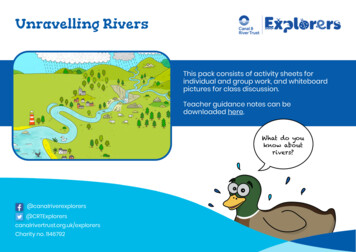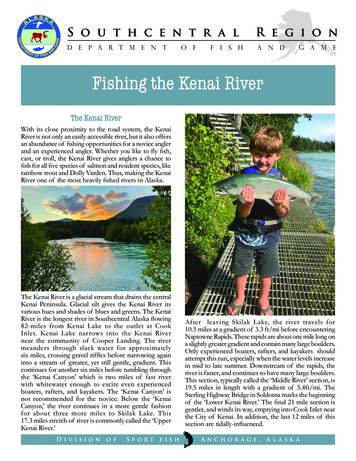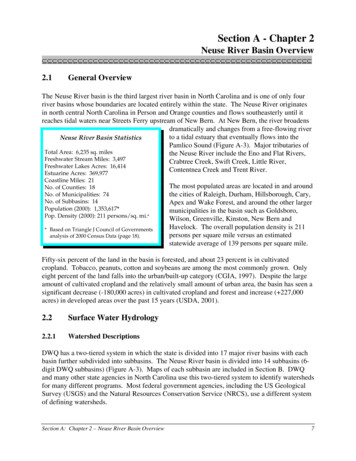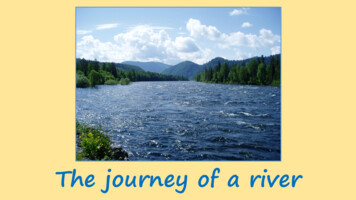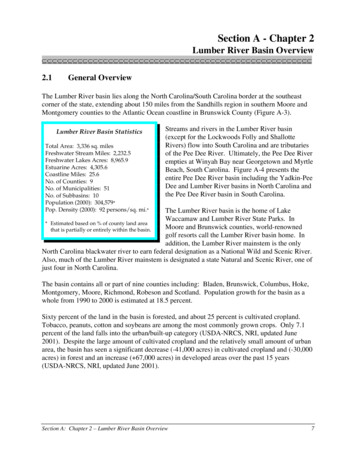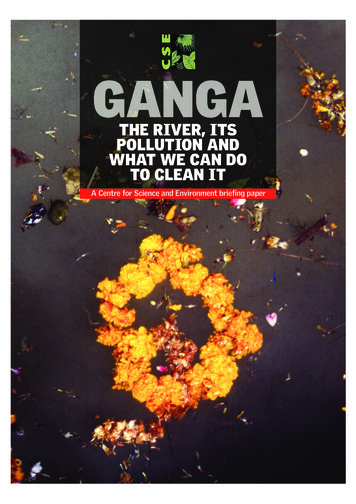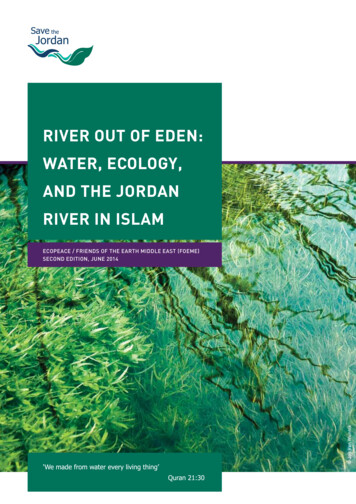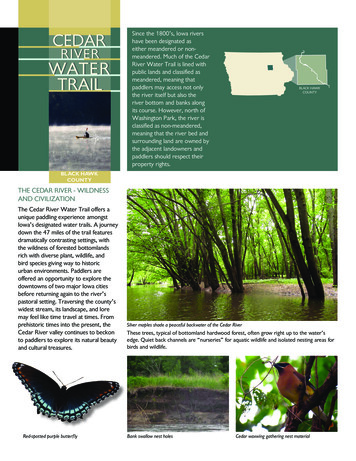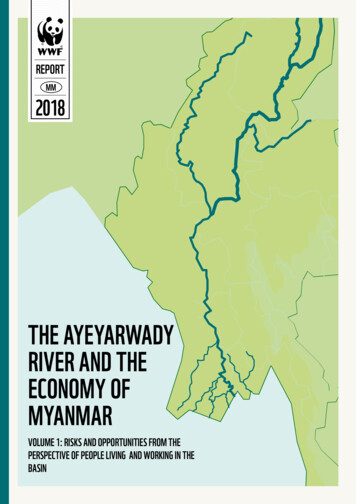
Transcription
REPORTMM2018THE AYEYARWADYRIVER AND THEECONOMY OFMYANMARVOLUME 1: RISKS AND OPPORTUNITIES FROM THEPERSPECTIVE OF PEOPLE LIVING AND WORKING IN THEBASIN
CONTENTSSUMMARYPublished inMay 2018 by WWF-World Wide Fund For Nature(Formerly World Wildlife Fund). Any reproduction in full orin part must mention the title and credit the above-mentionedpublisher as the copyright owner. Text 2018 WWFAll rights reservedISBN 978-2-940443-06-2WWF is one of the world’s largest and most experiencedindependent conservation organizations, with over5 million supporters and a global Network active inmore than 100 countries.WWF’s mission is to stop the degradation of the planet’snatural environment and to build a future in which humanslive in harmony with nature, by: conserving the world’sbiological diversity, ensuring that the use of renewable naturalresources is sustainable, and promoting the reduction ofpollution and wasteful consumption.Introduction4What makes the Ayeyarwady Unique?6A connected Ayeyarwady8Risks facing the Ayeyarwady sub basins9How do different sectors depend on the Ayeyarwady?10Agriculture12Fisheries16The Irrawaddy Dolphin18Mining & Extractives20Oil & Gas23Industry & Energy32CONCLUDING OBSERVATIONS35BIBLIOGRAPHY39
INTRODUCTIONMyanmar’s Ayeyarwady River is both unique and special. It isone of the largest free-flowing rivers in Southeast Asia. Thereis just one other river with this title, the Thanlwin or SalweenRiver, which also traverses Myanmar’s undulating landscapes.Although the river is “free-flowing”, it is not pristine. TheAyeyarwady is the engine of the Myanmar economy. It feeds the country’s populationwith fish and rice, and enables goods to be transported to people up and down theriver. Its waters are used to power turbines for electricity, while sand from its basin isa key component for infrastructure like houses, offices and roads.This document attempts to identify different ways that the Ayeyarwady River isimportant to both Myanmar’s economy and society. It also aims to highlight theimportance of balanced development that will ensure the naturally functioningsystems within the river continue to support growth and development, as theyhave for hundreds of years. It is a culmination of perspectives and inputs fromstakeholders along the river regarding their perceived risks and opportunities.45
WHATMAKESMAKESWHATTHE AYEYARWADY RIVERTHEAYEYARWADYRIVERUNIQUE?UNIQUE?SERVICES PROVIDEDBY THE RIVER CONTRIBUTE2-6 BILLION USDTO MYANMAR’S ECONOMYEVERY YEARCHINWIN RIVERMYANMAR’S LARGESTCITIES ARE IN THEAYEYARWADY BASINA BIG RIVERLength 2170 kmArea 413,710km291% lies in Myanmar, 5% in China, 4% in IndiaTHE BASINThe ARB (Ayeyarwady River Basin) is the largestand most economically significant river in MyanmarIt covers 61% of the country’s landmass.5 of Myanmar’s largest cities are in the basin34 MILLIONPEOPLE LIVE INTHE RIVER’S BASINAYEYARWADY RIVERTHIS HUGE RIVERCOVERS AN AREAMAGWAY6Yangon5 millionUNIQUE NATURAL DYNAMICSThe natural dynamics of the Ayeyarwady, particularly its sediment dynamics, are ofTHE SEDIMENT LIFELINEPYAYOne of the most biologically diverse regions in the worldaround 1,400 mammal, bird and reptile speciesMore than 100 of these species are globally threatened388 identified species of fish50% of these fish endemic to the Ayeyarwady RiverEach time the river is surveyed, new species are discoveredNayPyiDaw1.2 millionNAYPYIDAW particular interest. The Ayeyarwady is the 22nd largest river in the world in terms of waterThe basin is home to 66% of Myanmar’s population (34 million people)On average, there is 79 people per km2 living in the basinThe majority of these people live in the Ayeyarwady’s agricultural heartlands,the dry zone and the delta - particularly in Yangon and THAN GERMANYPEOPLE182,000Pathein0.9 million10% LARGERMonywaNEW SPECIESARE DISCOVEREDEVERY TIMETHE RIVER IS SURVEYEDBetween 261 and 354 million tons per year of suspended sediment coarse through theAyeyarwady’s waters every year. This sand, stone and rock are a lifeline and the mainenabler of the Ayeyarwady’s nutrient rich delta, which is home to thelargest concentration of people, fish and fields of rice paddies in the country.INVALUABLE SERVICESThe river has many other natural dynamics or ecosystem services including provisioning,BAGOregulating and supporting cultural services that take place in the Ayeyarwady Basin,supporting irrigation, inland water transport, fisheries, aquaculture, potable watersupply, biodiversity, and ecotourism. These were recently quantified in the State of theBasin Report (2018) to be worth 2-7 billion USD a year. These ecosystem services equateto between 6% and 16% of GDP per capita in Myanmar. Additional significant values notcalculated include the value of hydropower as well as positive and negative impacts offloods on the river system and ecosystem services. This document attempts to furtheridentify what values these ecosystem services provide towards the economy andsociety of Myanmar.7
A CONNECTED AYEYARWADYRISKS FACING THEAYEYARWADYSUB BASINSInterdependency of sectors and sub-basins with the Ayeyarwady RiverThe Ayeyarwady is at the heart of many activities in Myanmar. In each of its sub basins, a unique set ofneeds and risks is associated with the river. As part of the WWF-funded Ayeyarwady River in the EconomyProject, a series of workshops were held in each of these sub basins (upper, Chindwin, middle, lower anddelta) to identify the goods and services provided by the river, but also to identify how these demands areputting the river at risk, and ultimately the sectors themselves, which depend on a healthy Ayeyarwady.14%12%17%22%12%UPPER17%16%16%43%31%30 participants attended each workshop. They represented a diversity of backgrounds; academia,government, private sector and civil society. They identified the goods and services provided to theirsub basins that depend on their stretch of river. These include provisioning services such as water forirrIgation, regulating services such as flood recession ponds for fish spawning, supporting services such assafe habitats for biodiversity, and cultural services for tourism, as well as spiritual sites along the basin.CHINDWINMIDDLEThey were also asked to identify how these sectors providing goods and services are impacting upon theriver system, creating risks for the stretch of river in their region.8%The top risks identified in each sub-basin are shown in the following figure. These include flooding,mining, bank erosion, pollution, sedimentation, navigation challenges, river morphology changes, and fishspecies degradation.8LOWERIn addition to the individual risks identified within each localized sub-basin, there are also interlinkedrisks from up to downstream.BANK EROSIONFor instance, increased mining or deforestation in the upper catchment may shift the sediment dynamicsdownstream, causing bank erosion or sedimentation. As the Ayeyarwady flows through the country,hydropower dams trap sediment and may reduce the valuable ecosystem services provided to floodrecession agriculture in its lower stretches. Because of this sedimentation the river widens and becomesmore shallow, causing significant challenges for boats navigating the waters. The use of pesticides andfertilizers upstream also causes pollution for those using the river downstream. These are just a few of theways that risks are transported geographically throughout the entire river basin.FLOODINGIt is of paramount importance that economic development plans taking place, especiallyin the upper reaches of the Ayeyarwady and its tributaries, take into account their impacts on the usersdownstream. This includes not only water availability and quality, but also the timing of flows andsediment dynamics. For instance, the flooding risks identified by stakeholders in the lower basin maybe due to a sediment deficit in the upper reaches. This in turn limits the flow of sediment to the delta,contributing to its sinking. The lack of sediment may be due to a number of factors including regulationof flows from dams, the trapping of actual sediment from dams or perhaps the extraction of sedimentfor the construction sector. Individually these impacts may be small, but cumulatively they may result ina vulnerable delta, the home of the majority of Myanmar’s population, infrastructure, and fish and riceproduction.NAVIGATION PROBLEMS23%31%19%19%RIVER MORPHOLOGY CHANGESPOLLUTIONMININGSEDIMENTATIONBIODIVERSITY DEGRADATIONDELTA18%23%20%18%21%FISH SPECIES DEGRADATION9
SUPPORTDIFFERENTHOW DO DIFFERENT SECTORS DEPENDOF THE ECONOMY?ON THE RWADYRIVERSPIRITUAL EXPERIENCES &SENSE OF PLACEWATERPROVIDINGRAW MATERIALSFISH, FOOD &OTHER AQUATIC PRODUCTSREGULATINGSUPPORTINGFLOOD RMININGAGRICULTUREUSE OF PESTICIDES AND ORESTATIONOVERFISHINGFISH REDUCTIONAND WHAT ARE THEIMPACTS?1011
AGRICULTUREWHAT AND WHERE ARE THE CLIMATECHANGE RISKS FACING MYANMAR?Agriculture is one of the most significant contributors to the Myanmar economy.Agriculture represents: 32% of the GDP and 17.5% of the total export earningsAgriculture employs: 61.2% of the labour force (FAO 2009-2010).The huge value that Myanmar receives from the agricultural sector is largely dueto the ecosystem services provided by a healthy Ayeyarwady River. For instance, according to the State of the BasinReport, the estimated annual economic values attributable to irrigation water supplies (provisioning services) is 62 to121 million USD in the dry season and is 29 to 50 million USD due to yield gains in the monsoon season. This meansthat the clean water provided from the Ayeyarwady alone contributes 6% to the value of agricultural exports fromMyanmar. This is without considering the value of other ecosystem services including sediment nutrients for LLEXTREME DAYTEMPERATURESDROUGHTSEA LEVEL RISERice is the most cultivated crop in Myanmar (8 million hectares) but mainly during the monsoon season (withother crops grown during the dry season). Beans and pulses are the second most grown crop in the country (4million hectares), most of which are produced during the cool and dry season. Other important crops include maize,groundnuts, sesame, sunflower, and culinary crops (2.5 million hectares). The ARB is home to the majority of cropsgrown in the countryAyeyarwady BasinWHERE ARE MYANMAR’S CROPS 8517506.1ha224954.9ha1534ha93535.2haRest of the ICE PADDYOIL SEEDSCEREALSPULSESTOBACCO& BETELTEACOFFEESUGARCANEFRUITFIBREAGRICULTURE AT RISKMyanmar’s most productive agricultural zones (the Ayeyarwady Basin) are in the areas most vulnerable to climate change. In the face ofpotential cyclones, flooding, intense rainfall, extreme day temperatures, drought or sealevel rise, the country’s future food supply is at risk.For example, the main paddy producing region is the coastal and delta zone, particularly the Ayeyarwady basin, while the intensivemixed upland crop area is in the central dry zone. Under climate change projections, the coastal zone will experience increasedrainfall during a shorter and more intense wet season, leading to flooding . At the same time, sea level rise will increase inundationand lead to greater salinity intrusion in coastal areas. Cyclones will exacerbate these effects through associations with flooding,as well as wind damage. In the dry zone, drought risk will rise, particularly as the length of the monsoon shortens. This will becomplemented by increased heat stress, as maximum temperatures may rise up to 4 C by 2051.1213
RICERice accounts for 43% of all agricultural production value, nearly 5 times as high as the second highest valuecommodity, poultry. This is to be expected given the water resource advantages of Myanmar and the fertiledelta.When summed across all regions and states, it is evident that the Ayeyarwady Basin is akey region for agricultural production and is therefore rightfully referred to as the ‘ricebowl’ of Myanmar, with 71% of the country’s rice production coming from the AyeyarwadyBasin even though it represents only 69% of sown area of paddy in the basin. This meansthat rice grown in the delta is more productive per hectare than elsewhere in the basin.PULSESThe second most cultivated crop in Myanmar are pulses, a group that comprises black gram, green gram,chickpeas, pigeon peas, and other grams.India (58% importers of all legume exports) and China (18% importers of all legumeexports) are the largest buyers of Myanmar beans and pulses, resulting in Myanmar beingthe second largest global exporter of beans and pulses, after Canada.Pulses are now the top foreign exchange earner among agriculture commodities,representing 12% of total export value from the country (1.4 billion USD) .In FY2011, the area planted to pulses was estimated at 4.4 million hectares (about 55% ofthe area planted to paddy). They are sown mainly in the central dry zone, followed by delta,hilly, and coastal zones. According to the national agricultural statistics, 96% of all pulsesproduced within Myanmar are grown within the Ayeyarwady Basin.LIVESTOCKThe livestock and fisheries sector contributed 7.4% of GDP in FY2010. However, outside of official GDPnumbers, livestock is an integral part of the agricultural economy: cattle (and buffalo) provide draft powerand rural transport, dairy cattle provide milk, and other livestock and poultry provide food and income.In 2012, the livestock population comprised 14 million cattle, 3.1 million buffaloes, 4.6million sheep and goats, 10.3 million pigs, 172 million chickens, 15 million ducks, and1.9 million other poultry. Estimatedper capita consumption of meat is 11.3kilograms (compared to 88 kg perperson annually in Germany), milk (15.3kilograms), and eggs (52) per year.1MEAT PRODUCTION IN MYANMAR0.80.6THOUSAND TONS0.40.22001142005200820112013Cattle are densely populated in thecentral dry zone (Middle Ayeyarwady),making up about 50% of the country’stotal. The value of animal productsexports was 47.1 million in FY2012, alarge proportion from hides. This is smallcompared to the 641.7 million of fishexports (marine and freshwater) and 2600 million of crop exports. However,official statistics suggest that the growthin livestock and dairy production hasbeen much faster than for crops. This isindicated by the figure below, showingthe dramatic increase of meat production.Within the meat sector, chicken hasgrown fastest (accounting for 995,380MT, or 51.3% of total meat produced inFY2010), followed by pork and beef. Milkproduction has also made large gains.15
FISHERIESLike rice, fish is a major contributor to Myanmar’s national diet, estimated to account forapproximately 60% of animal protein intake. Nationally, the livestock and fisheries sectorcontributed 7.4% of GDP in FY2010.The Ayeyarwady Basin is the most important source of inland fisheries for the country. Bothfor wild caught fish but also increasingly for aquaculture as the for example, the AyeyarwadyDelta now represents 70% (Ayeyarwady and Yangon regions) of all ponds in the country. Therelative importance of the Ayeyarwady is show in the figure below .According to national statistics, fisheries provide jobs for approximately 3.2 million people (0.15% of totalemployment). The significant value attributed to fisheries, is especially dependent on a healthy Ayeyarwady River.According to the State of the Basin Assessment, the ecosystem services provided by the River range between 350 to530 million USD in freshwater capture and 380 to 600 million USD in aquaculture to Ayeyarwady basin.The growth of aquaculture (8% a year estimated) in the Ayeyarwady is a risk to the indigenousspecies in the basin. This risk is especially acute since there is so little known about thewild fish in the Ayeyarwady. For instance, the overall number of fish species recorded inthe Ayeyarwady Basin is 388, of which 311 are present in the Myanmar part. The othersbeing found in India and China. Among the 388 fish species, 193 (50 %) are endemic to thebasin, and 100 (26 %) of the endemics are presently known only from Myanmar. Importedexotic fish species tend to outcompete the natural, indigenous fish species within a river.According to the SOBA report on fisheries, “there is very little research around the benefits ornegative impacts of stocking natural water bodies with cultured fish. Fishers complain aboutcompetition between stocked fish and native fish, with a frequent reduction of the wild stock.In 2007, only 7.4% of the leasable fisheries yield consisted of species originally existing in thearea. This point requires further investigation.”According to updated statistics, Myanmar fish production is composed of three tiers: one third inland capture fish,one third marine capture fish and one third aquaculture fish, for a total of 2.9 million metric tons in 2015. Accordingto these statistics, Myanmar fish production is composed of about 863,000 metric tons or 30% of inland capturefish, 1,062,000 metric tons or 37% of marine capture fish, and 942,000 metric tons or 33% of aquaculture fish. Thetrends in fisheries production in Myanmar are shown below, where marine fisheries have remained relatively stable,aquaculture has grown at a rapid pace, while capture freshwater fish is believed to have dropped somewhat in the lastfew years.TRENDS IN MARINE CAPTURE FISHERIES,FRESHWATER FISHERIES AND AQUACULTUREMYANMAR INLAND FISHPOND AREA ACCORDING TOREGIONScapture marine fishcapture freshwater fishaquaculture fish2501501,500,000YANGON1,000,000TOTAL CATCH (t)POND AREA (’000 2006200820102012201417
THE IRRAWADDY RIVERDOLPHIN60IRRAWADDYDOLPHINSREMAIN IN THEAYEYARWADYRIVERIn addition to the fish, the Irrawaddy Dolphin is also at risk, and is currently criticallyendangered in Myanmar. There are roughly 60 dolphins left in the Ayeyarwady River.The Irrawaddy Dolphin habitat overlaps strongly with severe threats from growing humanactivities. The primary factor responsible for population declines is incidental mortality insmall-scale fisheries, especially gillnets and electro-fishing. Habitat loss and degradationis also a major contributing threat in many freshwater areas, especially from existing andplanned dams in the Ayeyarwady River, and in coastal estuarine habitats from decliningfreshwater flows, increasing commercial vessel traffic and pollution.“Some fishermen feel that a significant part of this stems from the fishing licenses offered bythe Ministry of Livestock, Fisheries and Rural Development. The competitive bidding processand the short-term length of the fishing contracts encourages over-fishing, to the detriment ofboth dolphins and the cooperative fisherman.”The Ayeyarwady River is one ofthe only places in the world wheredolphins work together with man tocatch fish. Sadly, this age-old allianceis under threat. Could tourism savethe Irrawaddy Dolphins?WORKING TOGETHEROne of the potential lifelines for the Irrawaddy Dolphin is cooperative fishing, wherebyfisherman and dolphins work together to catch their fish. Cooperative fishing is also moreeffective. In 2006 and 2007, DOF and WCS conducted a study, which found that dolphinassisted fishing resulted in fewer empty nets and higher weight and value of the catch.However, from 2011 to 2013, cooperative fisherman experienced a 17% drop in income. Over40% of the fishermen say they have no other source of income, while about 38% rely onadditional income from farming. Agricultural income is susceptible to seasonal shocks, whichmake it inconsistent from year to year.THE TOURISM LIFELINEEcotourism, in the form of tourists going to view the cooperative fishing, one of the onlyplaces in the world where this is practiced, in addition to seeing the endangered IrrawaddyDolphin, is hoped will relieve some of the financial pressures on the fishermen, reducing theneed to practice electrofishing. The potential for ecotourism for the dolphins is significant.The Mandalay Region, where most of the Irrawaddy Dolphin can be found, hosted more than38 5031 tourists in 2016. Among them, 19 810 tourists used river cruises. Although thesecruises were likely to go to Bagan, there is a potential for dolphin watching to be an additionalactivity. If this is the case, the same number of boat tours for dolphin watching could amountto an income of about 10.5million US in 2016.1819
MINING & EXTRACTIVESMyanmar’s natural resources include oil and gas, minerals including gold, silver and copper andgems such as rubies and jade. The extractive sector accounted for 6% of GDP, 23.6% of Staterevenue and 38.5% of exports in 2013.The mining sector is an important driver of economic growth and a source of employment. Artisanal mining iswidespread throughout the Ayeyarwady Basin but is a particularly important income source for many people in theUpper Ayeyarwady, Middle Ayeyarwady, and the Chindwin Basin.Mining in the Ayeyarwady Basin is a growing and important part of the Myanmar economy. Sagaing Region andMandalay Region are the two areas of the country home to the majority of the mines. Both of these areas are in theAyeyarwady Basin, hence the high proportion (87%) of mines that are found within the Ayeyarwady Basin.“Mining has expanded rapidlywithin the Ayeyarwady Basin andnow directly affects more than 740km2. This equates to almost 1% ofdegradation in the Chindwin Basinfrom mining activities alone.”WHERE ARE MYANMAR’S MINES?209 220Across Myanmar, there are 585 mines.509 of those are in the Ayeyarwady River Basin.6KAYAH STATE38 40 6SHAN STATEKACHIN STATEMON STATE631KAYIN BAGO REGIONAnalysis of remote sensing data suggests that mining has expanded rapidly within the Ayeyarwady Basin and now directly affects morethan 740 km2. This equates to almost 1% of degradation in the Chindwin Basin from mining activities alone. Much of this expansion is in theChindwin River Basin or around Mandalay.2021
OIL & GASMyanmar is an important natural gas and petroleum producer in Asia. It ishome to one of the world’s oldest petroleum industries, with its first crude oilexports dating back to 1853. Today, the country is one of the major natural gasproducers in the Asian continent.According to DICA, Myanmar has received more than US 69 billion in cumulative foreign directinvestment (FDI) as of January 2017. The oil and gas sector attracted over US 22.4 billion in FDIwhich is approximately 32% of the total FDI from 154 permitted foreign enterprises. This makesthe country’s oil and gas sector one of the top sectors for FDI in the country, followed by power,manufacturing, transport and communication.Most of the oil & gas blocks exist within the Ayeyarwady river basin, with the majority of the remainingwells situated offshore.The oil and gas within the Ayeyarwady basin is home to a large artisanal sector. Myanmar has a longhistory of artisanal oil extraction, with individuals or small informal enterprises extracting oil withequipment sometimes as simple as a bucket and rope. There is existing artisanal extraction in several oilfield areas that provides important primary or secondary livelihoods for communities.Hand-gouged wells are widespread in Ngashan Taung in Kyaukpadaung Township, Mandalay Region;Kalay township in Sagaing Region; and Myaing, Pauk, Gangaw and Minhla Townships in MagweRegion. In Minhla, there are tens of thousands of small-scale operations scattered over a couple ofdozen or more sites. Most operations occupy plots as small as 5 to 10 square feet. The governmentneeded to introduce tighter safety and environmental standards to the hand-gouged oil business.These small-scale industries are responsible for significant deforestation within the basin, due to theirneed to burn the crude oil for refining into more appropriate fuels. This creates negative impacts on theriver basin as a whole, including reduced water retention and increased erosion of sediments into theAyeyarwady River.“Even these small-scale industries areresponsible for significant deforestationwithin the basin, due to their need toburn the crude oil for refining into moreappropriate fuels.”2223
INDUSTRY & MANUFACTURINGThe economic contribution of the industry sector to the economy rose substantially from 26.5%in 2010 to 34.4% in 2014, while the share of agriculture shrank from 36.8% to 27.9% in thesame period. Myanmar’s industrial sector has grown rapidly in recent decades.Most of the industrial activity is located close to the major urban and transport centres in the Ayeyarwady Basin,especially the large cities of the Middle Ayeyarwady, the Lower Ayeyarwady, and the Ayeyarwady Delta.“Small-scale industries cancause significant waterpollution.”Myanmar’s industrial sector is diverse and includes activities, such as food and beverages; clothing and apparel;construction materials; personal, electrical, and household goods; printing and publishing; industrial raw materials;minerals and petroleum products; agricultural and industrial machinery/equipment; transport vehicles; and electricalgoods.Food and beverages are the major industrial sub-sector in Myanmar, accounting for approximately 62% of thenational industrial operation. Major food and beverage developments are located in Yangon and Mandalay, garmentmanufacturing in Pathein and Yangon, and mineral and petroleum product manufacturing in Monywa and Mandalay.Small-scale enterprises make up 80% of the industrial sectorwithin the Ayeyarwady Basin. While small-scale industrydominates smaller population centres, it is also prominent inurban centres, making up 42% of the total industry in Yangonand 50% in Mandalay. Small-scale industries can causesignificant water pollution risk due to inadequate treatmentprocesses and lack of knowledge to mitigate pollution risks.KACHINREGISTERED INDUSTRY IN STATES AND REGIONS ACROSSMYANMARSMALL-SCALE MEDIUM-SCALE LARGE-SCALESAGAINGSHANCHINMAGWAYRAKHINEMANDALAYNAY PYI ACHINSAGAINGSHANCHINMANDALAYMAGWAYRAKHINENAY PYI 5335027351306172681422547828226599016818925
NAVIGATIONMyanmar has an extensive river network that is well positioned to serve thecountry’s main transport corridors, including the link between Yangon andMandalay. However, inland water transport is facing unprecedented pressures atthe moment.Main rivers are difficult to navigate because of shallow waters during the dry season, shifting navigationchannels, and lack of terminal facilities. However, growth projections remain high, and the sector has beenidentified as a major bottleneck for increased trade both within the country and within the region.The Ayeyarwady Basin is home to 70% of all navigable rivers in Myanmar. The majority of navigationis represented by transport between Yangon, Mandalay and Bawmaw. Passenger transportation is thehighest in Ayeyarwady Region and cargo transportation is the highest in Mandalay Region.According to the AIRBM Synthesis State of the Basin Report, “in the last few years there has beena significant reduction in waterborne freight transport. A number of factors are perceived to havecontributed to this including a backlog of dredging works, slow loading and unloading times, and thegrowth of land-based transport.”Navigation is impacted by changes in river flows, sediment transport, the seasonality of flow and the onsetof the monsoon season. Many of the activities taking place within the basin hinder navigation includingindustrial pollution or the regulation of tributaries through dam infrastructure. Other activities such assand mining in areas that require dredging are seen as supporting navigation. However, the sedimentdynamics of areas where sand or gravel is being extracted, and the impact downstream is less understood.“Many of the activities takingplace within the basin hindernavigation, including industrialpollution or the regulationof tributaries through daminfrastructure.”2627
CONSTRUCTIONConstruction accounts for around 5.2% of GDP or around 18% of industrial output.Even with this small economic contribution (directly), the sector has devastatingimpacts on the river.However, the construction sector has important linkages with othersectors of the economy. For instance, approximately 30% of outstanding credit from the banking sector isfor construction and real estate. Therefore, not only is employment affected with a slowing or uncertainconstruction sector, but the banking sector sees risks too. “Improving regulations in the constructionsector, and ensuring that these are enforced, is critical though needs to be managed carefully. Betterregulations could improve urban planning, the quality of construction, environmental sustainability, andthe welfare of urban dwellers. Ensuring a phased approach that is predictable and transparent is criticalto avoid big shocks, which may be difficult for the economy to recover from given the importance of theconstruction sector.” (World Bank, 2016)Sandmining has devastatingimpacts on the river.More importantly for the Ayeyarwady River, the construction sector is a driver for the extraction of sand.Typically, coarse sand and gravel is targeted for extraction, as these are the most desirable constructionmaterials. Approximately 10 million tonnes of gravel and sand a year are repo
INTRODUCTION Myanmar's Ayeyarwady River is both unique and special. It is one of the largest free-flowing rivers in Southeast Asia. There is just one other river with this title, the Thanlwin or Salween River, which also traverses Myanmar's undulating landscapes. Although the river is "free-flowing", it is not pristine. The

